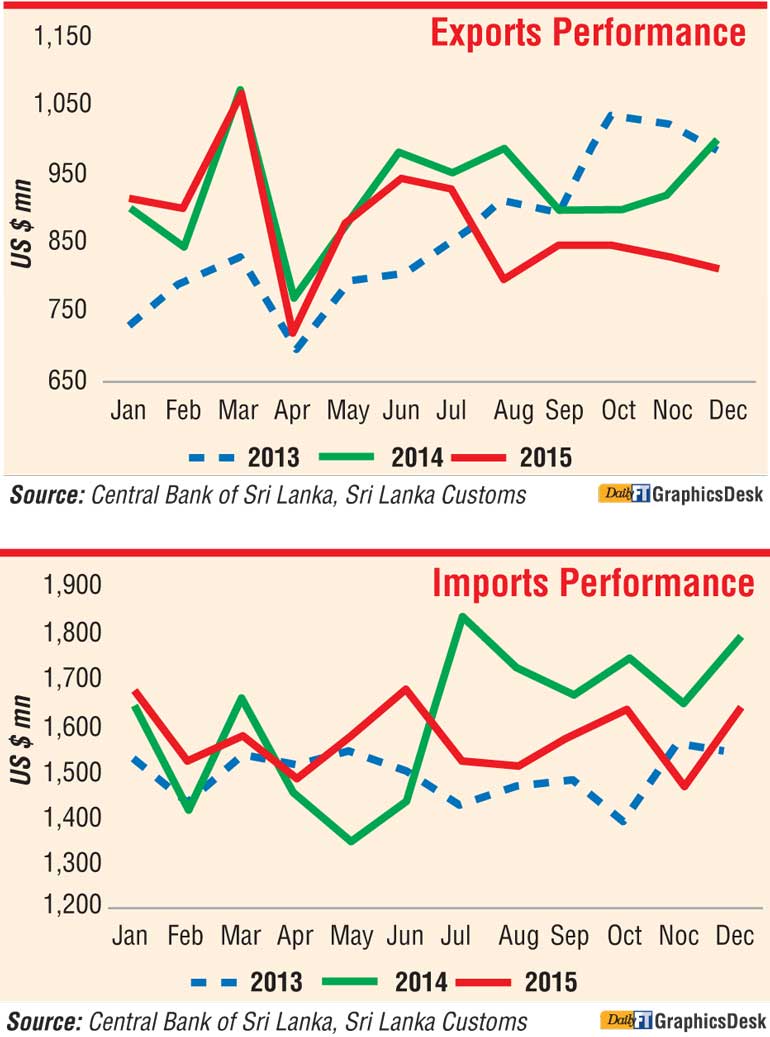Friday Nov 15, 2024
Friday Nov 15, 2024
Saturday, 5 March 2016 00:00 - - {{hitsCtrl.values.hits}}

The Central Bank said yesterday Sri Lanka’s external sector showed a mixed performance in the month of December 2015 with a widened trade deficit, continued high growth in tourist earnings and moderate workers’ remittances.
On a cumulative basis, the trade deficit widened marginally during 2015, while earnings from tourism increased significantly. Meanwhile, workers’ remittances recorded a marginal decline in 2015. The major source of inflows to the financial account of the BOP during 2015 were the issuance of two international sovereign bonds and swap arrangement of the Reserve Bank of India.
Earnings from exports continued its downward trend for the tenth consecutive month in December 2015 recording an 18.7% decline, year-on-year, to $817 million, led by textile and garments and tea exports.
Export earnings from textile and garments, which contribute nearly 48% to the total exports, declined for the third consecutive month by 12.8% in December 2015, reflecting low exports to both EU and USA markets. However, garment exports to non-traditional markets such as Canada, China and UAE increased slightly by 1.7%, year-on-year, during the month.
Lower demand for tea exports continued throughout the year 2015 due to economic and geo-political developments in the main tea export destinations. Accordingly, earnings from tea exports in December dropped by 24.7%, reflecting declines in both export volume and average price levels compared to the corresponding month in the previous year.
Further, transport equipment, rubber products and gems, diamonds and jewellery exports also contributed significantly to the drop in December exports. The substantial drop shown in transport equipment was largely as a result of base effect due to the export of a cruise ship in December 2014.
Earnings from rubber product exports continued to weaken and recorded a 19.8% decline, year-on-year, in December 2015. However, petroleum product exports recorded a 24.5% increase as a result of a substantial increase in bunkering quantity by 186.4%, year-on-year, in December 2015. Adding to that, earnings from chemical products also showed a growth of 10.5% while sub categories of cinnamon, woven fabrics and fruits showed a growth in the month of December 2015, over the corresponding month in 2014.
Deviating from the normal seasonal trend of increased expenditure on imports towards the end of the year, expenditure on imports weakened for the sixth consecutive month in December 2015 by 8.5% to $1,645 million, year-on-year.
A large part of this decline in growth was attributable to the drop in imports of intermediate goods led by fuel imports, while the drop in imports of consumer goods and investment goods also contributed. In December 2015, expenditure on fuel imports decreased by 15.5%, year-on-year, to $216 million mainly due to the considerable decline in import prices.
In line with the downward movement in international oil prices, average import price of crude oil dropped to $41.21 per barrel in December 2015, compared to $75.98 per barrel recorded in December 2014.
Consumer goods imports decreased by 9.1% to $384 million, in December 2015. Substantial decline recorded in imports of personal motor vehicles and rice imports contributed largely for the reduction of expenditure on consumer goods imports. Expenditure on rice imports declined for the eighth consecutive month in December 2015 to $1.7 million compared to $50.0 million in December 2014, owing to the increased local production of rice.
Expenditure on importation of personal motor vehicles dropped significantly by 41.1% to $66 million in December 2015, reflecting declines recorded in all sub categories including motor cars and motorcycles. Expenditure on transport equipment such as trishaws, buses and agricultural tractors, categorised under investment goods, declined significantly by 49.8%, year-on-year.
However, import expenditure on vegetables, textile and textile articles and machinery and equipment, which is categorised under consumer goods, intermediate goods and investment goods, respectively, increased significantly during the month.
Reflecting the subdued global demand and lower commodity prices, earnings from exports during 2015 decreased by 5.6% to $10,505 million while expenditure on imports declined by 2.5% to $18,935 million. Lower performance in tea, rubber products, textile and garments and seafood exports contributed mainly for the drop in exports.
Significant decline recorded in fuel import bill due to lower oil prices and lower thermal power generation caused for the decline in import expenditure. The leading markets for merchandise exports of Sri Lanka during 2015 continued to be the USA, UK, India, Germany and Italy accounting for about 51% of total exports, while the main import origins continued to be India, China, Japan, UAE and Singapore accounting for about 60% of total imports.
The deficit in the trade account increased to $827 million in December 2015, compared to $792 million in December 2014. On a cumulative basis, the trade deficit during 2015 expanded marginally by 1.7% to $8,430 million over 2014.